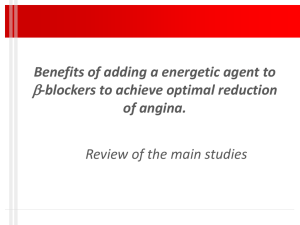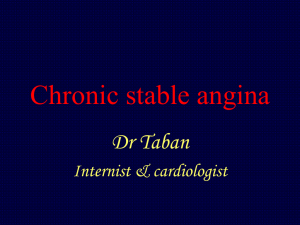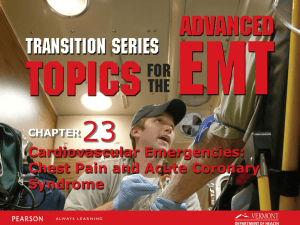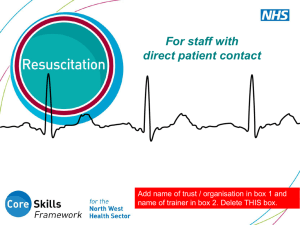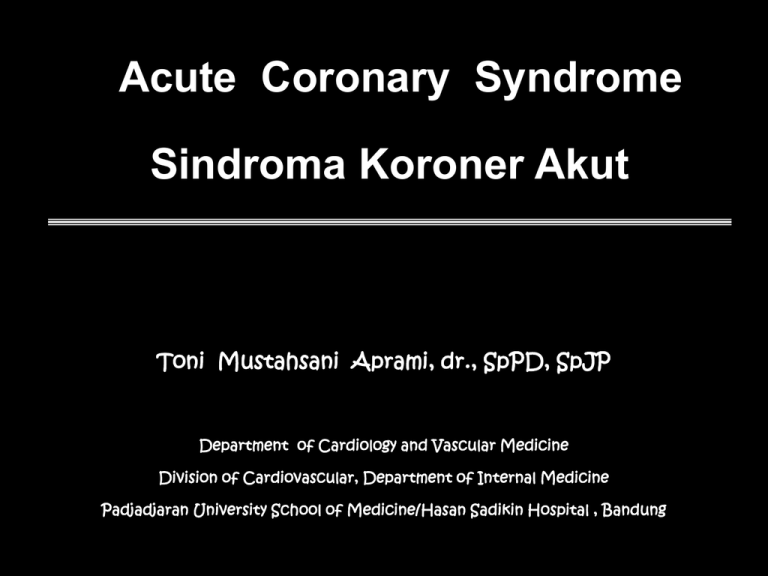
Acute Coronary Syndrome
Sindroma Koroner Akut
Toni Mustahsani Aprami, dr., SpPD, SpJP
Department of Cardiology and Vascular Medicine
Division of Cardiovascular, Department of Internal Medicine
Padjadjaran University School of Medicine/Hasan Sadikin Hospital , Bandung
DEFINISI
Suatu sindroma klinik yang menandakan
adanya iskemia miokard akut, terdiri dari :
Infark miokard akut Q wave (STEMI)
Infark miokard akut non-Q (NSTEMI)
Angina pektoris tidak stabil (UAP)
Ketiga kondisi ini sangat berkaitan erat, berbeda
hanya dalam derajat beratnya iskemi dan
luasnya miokard yang mengalami nekrosis.
2
PATOGENESIS
• Umumnya disebabkan oleh aterosklerosis
koroner
• Plak aterosklerosis ruptur terbentuk
trombus diatas ateroma yang secara akut
menyumbat lumen koroner
• Apabila sumbatan terjadi secara total
hampir seluruh dinding ventrikel akan
nekrosis
3
Risk Factors
Uncontrollable
Controllable
•Sex
•High blood pressure
•Hereditary
•High blood cholesterol
•Race
•Smoking
•Age
•Physical activity
•Obesity
•Diabetes
•Stress and anger
The cardiovascular continuum of events
Ischemia = oxygen supply
and demand imbalance
Myocardial
Ischemia
CAD
plaque
Atherosclerosis
Risk Factors
( DYSLIPIDEMIA , BP, DM,
Insulin Resistance, Platelets,
Fibrinogen, etc)
Adapted from
Dzau et al. Am Heart J. 1991;121:1244-1263
The cardiovascular continuum of events
Coronary
Thrombosis
Myocardial
Ischemia
CAD
Atherosclerosis
Risk Factors
( DYSLIPIDEMIA , BP, DM,
Insulin Resistance, Platelets,
Fibrinogen, etc)
Adapted from
Dzau et al. Am Heart J. 1991;121:1244-1263
The cardiovascular continuum of events
ACS
Coronary
Thrombosis
Myocardial
Ischemia
CAD
Atherosclerosis
Risk Factors
( DYSLIPIDEMIA , BP, DM,
Insulin Resistance, Platelets,
Fibrinogen, etc)
Adapted from
Dzau et al. Am Heart J. 1991;121:1244-1263
Coronary
Plaque
Stable
UA/NSTEMI
STEMI
thrombosis
rupture
angina
Penyempitan
Pembuluh darah
Clinical Spectrum of Acute Coronary Syndrome
Acute Coronary Syndrome
ST Segment
Elevation
Non-ST Segment
Elevation
STEMI
NSTEMI
Unstable
Angina Pectoris
Non-Q-wave
Q-wave
Acute Myocardial Infarction
Unstable
Angina
Non occlusive
thrombus
Non specific
ECG
Normal
cardiac
enzymes
NSTEMI
Occluding thrombus
sufficient to cause
tissue damage & mild
myocardial necrosis
STEMI
Complete thrombus
occlusion
ST elevations on
ECG or new LBBB
ST depression +/T wave inversion on
ECG
Elevated cardiac
enzymes
Elevated cardiac
enzymes
More severe
symptoms
Diagnosis
Anamnesis
Pemeriksaan Fisik
Pemeriksaan Penunjang :
1. Laboratorium
2. Elektrokardiografi
3. Thoraks Foto
HISTORY
PRODROMAL SYMPTOMS
History very valuable to establish D/. Prodoma : chest discomfort –
unstable angina
1/3 symptoms for 1 – 4 wks
20% symptoms for < 24 hrs
Malaise, exhaustion
NATURE OF PAIN
• Most patients
severe prolonged, 30 minutes - hours
• Constricting, crushing, oppressing, compressing
heavy weight or squeezing in chest
• Choking, vise-like, heavy pain or stabbing, knife-like, boring or
burning discomfort
• Location : retrosternal, spreading frequently to both sides of the
chest with predilection to the left side
• Often pain radiates down ulnar aspect of left arm, producing
13
tingling sensation in left wrist, hand and fingers
NATURE OF PAIN
• SOME INSTANCES : pain begins in epigastrium, and simulates
abdominal disorder
• Sometimes pain radiates to shoulders, upper extremities, neck, jaw
and interscapular region favoring the left side
• Elderly : no chest pain but acute left ventricular failure and chest
tightness or marked weakness or syncope
• Pain arises from nerve endings in ischemic or injured, but not necrotic,
myocardium
OTHER SYMPTOMS
50% nausea or vomiting in transmural infarcts
Occasionally diarrhea, profound weakness, dizziness, palpitation, cold
perspiration, sense of impending doom
Occasionally : cerebral embolism or systemic arterial embolism
14
Pain Patterns with Myocardial
Ischemia
15
Anamnesis untuk UAP
• 3 kategori presentasi klinik UAP:
Angina saat istirahat (resting angina)
Angina awitan baru (new onset angina)
Angina yang bertambah berat (increasing
angina)
• Riwayat penyakit dahulu :
Riwayat angina on effort, infark
operasi pintas
Riwayat penggunaan nitrogliserin
Identifikasi faktor-faktor risiko
atau
16
PHYSICAL EXAMINATION
GENERAL APPEARANCE
Anxious, considerable distress,
(Levine sign)
LV failure & symp. stimulation :
dyspnea, cough with frothy
sputum.
Shock : cool, clammy skin,
confusion or disorientation
restless, fist on chest
cold perspiration, pallor,
pink or blood-streaked
facial pallor, cyanosis,
HEART RATE
Variable depending on underlying rhythm and degree or
ventr. failure
Most commonly, HR 100 – 110/min; > 95% patients :
VPB’s within first 4 hours 17
BLOOD PRESSURE
Majority normotensive, but syst. BP may decline and diast.
BP may rise
Half of pts with inferior MI parasympathetic stimulation
: hypotension, bradycardia or both (Bezold – Jarisch
reflex)
half of pts with anterior MI, sympathetic excess :
hypertension, tachycardia or both
TEMPERATURE AND RESPIRATION
Most pts with extensive MI fever within 24-48 hrs, fever
resolves by 4th or 5th day
Respiration due to anxiety and pain, in LV failure : resp.
rate correlates with degree of heart failure
18
JUGULAR VENOUS PULSE
JVP usually normal
RV infarction : marked jug. venous distension
CAROTID PULSE
Small pulse reduced stroke volume
Pulse alternans : severe LV dysfunction
19
CHEST
LV failure and/or LV compliance ↓ : moist rales
Severe failure : diffuse wheezing, cough + hemopthysis
1967 : Killip & Kimball : prognostic classification
Class
I
: patients free of rales or S3
II
: rales < 50% lung fields +/- S3
III : rales > 50% lung fields, frequently
pulm. edema
IV : cardiogenic shock
20
Pemeriksaan Penunjang
• Pemeriksaan EKG
Gambaran EKG infark miokard akut Q-wave (STEMI) :
Elevasi segmen ST 1 mm pada 2 sadapan
extremitas
Atau 2 mm pada 2 sadapan prekordial yang
berurutan
Atau gambaran LBBB baru atau diduga baru
21
ST-segment elevation
Gambaran EKG infark miokard akut non-Qwave (NSTEMI) atau angina pektoris tidak
stabil (UAP) :
– Depresi segment ST atau gelombang T
terbalik pada 2 sadapan berurutan
– Inversi gelombang T minimal 1 mm pada 2
sadapan atau lebih yang berurutan.
– Perubahan segment ST saat keluhan dan
kembali normal saat keluhan hilang
sangat menyokong UAP
25
ST-segment depression
T-wave inversion
ELEKTROKARDIOGRAM
Current-of-injury patterns with acute
ischemia
28
• Pemeriksaan Penanda Jantung/Enzim jantung
(Cardiac Markers):
Yang lazim adalah CKMB, dapat pula troponin T (TnT)
atau troponin I (TnI)
Peningkatan marka jantung akan terlihat pada infark
miokard akut Q-wave (STEMI) dan non-Q-wave
(NSTEMI)
29
Plot of the appearance of cardiac markers in
blood versus time after onset of symptoms
A myoglobin
B troponin
C CK-MB
D troponin in UA
30
Diagnosis Banding
1. Diseksi aorta
2. Perikarditis
3. Nyeri angina
hipertrofi
atipikal
pada
kardiomiopati
4. Penyakit esofageal, GI atas atau traktus biliaris
5. Penyakit paru-paru : pneumotoraks, emboli,
pleuritis
6. Sindroma hiperventilasi
7. Gangguan
neurogen
8. Psikogen
dinding
dada
:
muskuloskeletal,
31
Manajemen
The cardiovascular continuum of events
ACS
Coronary
Thrombosis
Myocardial
Ischemia
CAD
Atherosclerosis
Risk Factors
( DYSLIPIDEMIA , BP, DM,
Insulin Resistance, Platelets,
Fibrinogen, etc)
Arrhythmia and
Loss of Muscle
Remodeling
Ventricular
Dilatation
Congestive
Heart Failure
End-stage Heart
Disease
Adapted from
Dzau et al. Am Heart J. 1991;121:1244-1263
DELAY TO THERAPY
1. From onset of symptoms to patient recognition
2. Out-hospital transport
3. In-hospital evaluation
ISCHEMIC CHEST PAIN ALGORYTHM
Chest pain suggestive of ischemia
ISCHEMIC CHEST PAIN
TYPICAL ANGINA
EQUIVALENT ANGINA
1. NO CHEST DISCOMFORT
1. CHEST DISCOMFORT
2. LOCATION
2. LOCATION
3. INDIGESTION
3. RADIATION
4. UNEXPLAINED WEAKNESS
4. UNLIKELINESS
5. DIAPORESIS
6. SHORTNESS OF BREATH
Acute coronary syndrome algorithm
Chest discomfort suggestive of ischemia
Immediate ED assessment and immediate ED general treatment
2005 AHA-ILCOR Guidelines for CPR and ECC. Circulation 2005;112 (Suppl):IV-90
Chest discomfort suggestive of ischemia
Immediate ED assessment ( 10 min)
Immediate ED general treatment
• Vital sign
• O2 at 4 L/min (maintain O2 sat 90%)
• Oxygen saturation
• Aspirin 160-325 mg
• Obtain IV access
• Nitroglycerin SL, spray, or IV
• Obtain ECG 12 lead
• Morphine IV 2-4 mg repeated every
• Brief history and physical exam
5-10 minutes (if pain not relieved
• Check contraindication for fibrinolytic
with nitroglycerine)
• Initial serum cardiac markers
• Initial electrolyte and coagulation
Memory: “MONA” greets all patients
study
• Portable chest x-ray ( 30 minutes)
2005 AHA-ILCOR Guidelines for CPR and ECC. Circulation 2005;112 (Suppl):IV-90
Acute coronary syndrome algorithm
Chest discomfort suggestive of ischemia
Immediate ED assessment and immediate ED general treatment
Review initial 12 lead ECG
2005 AHA-ILCOR Guidelines for CPR and ECC. Circulation 2005;112 (Suppl):IV-90
Acute coronary syndrome algorithm
Chest discomfort suggestive of ischemia
Immediate ED assessment and immediate ED general treatment
Review initial 12 lead ECG
ST elevation or new or
presumably new LBBB
strongly suspicious for
injury
2005 AHA-ILCOR Guidelines for CPR and ECC. Circulation 2005;112 (Suppl):IV-90
Acute coronary syndrome algorithm
Chest discomfort suggestive of ischemia
Immediate ED assessment and immediate ED general treatment
Review initial 12 lead ECG
ST elevation or new or
presumably new LBBB
strongly suspicious for
injury
ST-depression or
dynamic T-wave
inversion strongly
suspicious for injury
2005 AHA-ILCOR Guidelines for CPR and ECC. Circulation 2005;112 (Suppl):IV-90
Acute coronary syndrome algorithm
Chest discomfort suggestive of ischemia
Immediate ED assessment and immediate ED general treatment
Review initial 12 lead ECG
ST elevation or new or
presumably new LBBB
strongly suspicious for
injury (STEMI)
ST-depression or
dynamic T-wave
inversion strongly
suspicious for injury
(UA/NSTEMI)
Normal or nondiagnostic changes
in ST-segment or Twaves (intermediate/
low-risk UA)
2005 AHA-ILCOR Guidelines for CPR and ECC. Circulation 2005;112 (Suppl):IV-90
Acute coronary syndrome algorithm
Chest discomfort suggestive of ischemia
Immediate ED assessment and immediate ED general treatment
Review initial 12 lead ECG
ST elevation or new or
presumably new LBBB
strongly suspicious for
injury (STEMI)
ST-depression or
dynamic T-wave
inversion strongly
suspicious for injury
(UA/NSTEMI)
Normal or nondiagnostic changes
in ST-segment or Twaves (intermediate/
low-risk UA)
Start adjunctive treatment
2005 AHA-ILCOR Guidelines for CPR and ECC. Circulation 2005;112 (Suppl):IV-90
ADJUNCTIVE TREATMENT
(Do not delay reperfusion)
1. Beta-adrenergic receptor blocker
2. Clopidogrel
3. Heparin (UFH or LMWH)
2005 AHA-ILCOR Guidelines for CPR and ECC. Circulation 2005;112 (Suppl):IV-90
Acute coronary syndrome algorithm
Chest discomfort suggestive of ischemia
Immediate ED assessment and immediate ED general treatment
Review initial 12 lead ECG
ST elevation or new or
presumably new LBBB
strongly suspicious for
injury
ST-depression or dynamic
T-wave inversion strongly
suspicious for injury
Normal or nondiagnostic changes in
ST-segment or Twaves
Start adjunctive treatment
Time from onset of
symptoms
12 hours
- Reperfusion strategy: PCI (90
min) or fibrinolysis (30 min)
- ACE-I/ARB
- Statin
2005 AHA-ILCOR Guidelines for CPR and ECC. Circulation 2005;112 (Suppl):IV-90
Acute coronary syndrome algorithm
Chest discomfort suggestive of ischemia
Immediate ED assessment and immediate ED general treatment
Review initial 12 lead ECG
ST elevation or new or
presumably new LBBB
strongly suspicious for
injury
ST-depression or dynamic
T-wave inversion strongly
suspicious for injury
Start adjunctive treatment
Start adjunctive treatment
Normal or nondiagnostic changes in
ST-segment or Twaves
Time from onset of
symptoms
12 hours
- Reperfusion strategy: PCI (90 min)
or fibrinolysis (30 min)
- ACE-I/ARB within 24 hours of onset
- Statin
2005 AHA-ILCOR Guidelines for CPR and ECC. Circulation 2005;112 (Suppl):IV-90
Adjunctive treatment
• Heparin (UFH/LMWH)
• Glycoprotein IIb/IIIa receptor inhibitors
• -Adrenoreceptor blockers
• Clopidogrel
2005 AHA-ILCOR Guidelines for CPR and ECC. Circulation 2005;112 (Suppl):IV-90
Chest discomfort suggestive of ischemia
Immediate ED assessment and immediate ED general treatment
Review initial 12 lead ECG
ST elevation or new or
presumably new LBBB
strongly suspicious for
injury
ST-depression or dynamic
T-wave inversion strongly
suspicious for injury
Start adjunctive treatment
Start adjunctive treatment
Time from onset of
symptoms
12 hrs
Normal or nondiagnostic changes in
ST-segment or Twaves
Admit to monitored bed
Assess risk status
12 hours
- Reperfusion strategy: PCI (90
min) or fibrinolysis (30 min)
- ACE-I/ARB within 24 h of
symptom onset)
- Statin
- High risk: early invasive
strategy
- Continue ASA, heparin,
ACE-I, statin
2005 AHA-ILCOR Guidelines for CPR and ECC. Circulation 2005;112 (Suppl):IV-90
VERY HIGH-RISK PATIENT
1. Refractory chest pain
2. Recurrent/persistent ST deviation
3. Ventricular tachycardia
4. Hemodynamic instability
5. Sign of pump failure
6. Shock within 48 hours
2005 AHA-ILCOR Guidelines for CPR and ECC. Circulation 2005;112 (Suppl):IV-90
Chest discomfort suggestive of ischemia
Immediate ED assessment and immediate ED general treatment
Review initial 12 lead ECG
ST elevation or new or
presumably new LBBB
strongly suspicious for
injury
ST-depression or dynamic
T-wave inversion strongly
suspicious for injury
Normal or nondiagnostic changes in
ST-segment or Twaves
Start adjunctive treatment
Start adjunctive treatment
Develops high or
intermediate risk criteria
or troponin-positive
Time from onset of
symptoms
12 hrs
Admit to monitored bed
Assess risk status
Monitored bed in ED
12 hours
- Reperfusion strategy: PCI (90
min) or fibrinolysis (30 min)
- ACE-I/ARB within 24 h of
symptom onset)
- Statin
- High risk: early invasive
strategy
- Continue ASA, heparin,
ACE-I, statin
Develops high or
intermediate risk criteria
or troponin-positive
No evidence of ischemia and MI: discharge with follow-up
2005 AHA-ILCOR Guidelines for CPR and ECC. Circulation 2005;112 (Suppl):IV-90
Pengobatan Pasca Perawatan
Obat-obat untuk mengontrol keluhan iskemia
harus dilanjutkan
Aspirin
Beta-blocker
ACE inhibitor
Modifikasi Faktor Risiko
Berhenti merokok
Pertahankan BB optimal
Aktivitas fisik sesuai dengan hasil treadmill
Diet
Rendah lemak jenuh dengan kolesterol, bila perlu
dengan target LDL < 100 mg/dL
Pengendalian hipertensi
Pengendalian ketat gula darah pada penderita DM
53
•Get regular medical checkups.
•Control your blood pressure.
•Check your cholesterol.
•Don’t smoke.
•Exercise regularly.
•Maintain a healthy weight.
•Eat a heart-healthy diet.
•Manage stress.
Thank you for your attention
Anamnesis
• Nyeri dada atau nyeri epigastrium hebat yang mengarah
pada iskemia miokard :
Seperti dihimpit benda berat
Terasa tercekik
Rasa ditekan, ditinju, ditikam
Rasa terbakar
Biasanya dirasakan dibelakang stenum seluruh dada
terutama kiri, dapat ke tengkuk, rahang, bahu,
punggung, lengan kiri atau kedua lengan
• Terutama laki-laki > 35 tahun dan Wanita > 40 tahun
• Seringkali disertai mual atau muntah, dapat pula rasa
tidak enak disertai sesak nafas, lemah, penurunan
kesadaran, dan keringat banyak
56
Pemeriksaan Fisik
• Biasanya penderita tampak cemas, gelisah, pucat, dan
keringat dingin
• Periksa tanda-tanda vital :
Denyut nadi cepat, reguler tetapi dapat pula bradi
atau tachycardia, irama ireguler
Tekanan darah biasanya normal bila belum terjadi
komplikasi, dapat pula terjadi hipo atau hipertensi
Bunyi jantung dapat terdengar redup
S3 dapat terdengar bila kerusakan miokard luas
Paru-paru dapat terdengar ronkhi basah dan atau
wheezing yang menandakan terjadinya bendungan
paru tergantung ada tidaknya gangguan fungsi
57
ventrikel kiri


